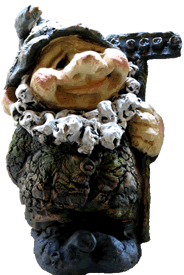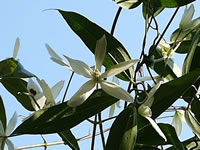How to grow and care for Clematis Plants
     
Clematis require about 6 hours of full sun per day to grow best although some light shading during the hottest part of the day is beneficial. It is essential for the roots to remain cool and moist so protect the root area with a heavy mulch or the shade of low growing plants. Even a large flat rock will work.
A few of the very large flowered varieties should be planted in a more easternly exposure to prevent excessive flower fading caused by to much sun.
Planting Clematis Vines |
 |
You can plant your clematis in early spring, as soon as the soil is workable,but if the plant has already started budding it must be protected from frost. Dig a hole about a foot in diameter and 15 inches deep, large enough to allow for ample root growth.The soil should be well-draining and rich, with a pH close to neutral (6.6-7.0). Clematis like peaty soil, but you must add enough lime to ensure the soil is not to acidic. Generous amounts of bone meal and compost should be added to the soil, coarse builder's sand should be added to soils which have a high clay content. Position the plant in the hole so that the roots are spread over a mound of soil in the bottom of the hole. The roots should be 2" below the soil line when you are finished. Set a stake next to the plant for support. Most clematis will require staking so the twining leaf petioles can cling and climb upward, although it is not a problem if you choose to let the plants sprawl over the ground, fences, or whatever. Fill in the hole, and water liberally to promote good root-to-soil contact. Provide the plant with a ground cover plant or a mulch such as shredded leaves, pine needles, straw, bark or even stones to help conserve moisture and to keep the roots cool. |
|
Clematis care
Clematis resent root disturbance, so extreme care must be exercised when working around the plant to prevent any root damage. Water well, keeping the soil always moist during the first year after planting. Fertilizer such as 5-10-10 should be applied twice during the growing season.
Clematis flowers form either on the current season's growth or on that of the previous year. Clematis that form its buds on the new growth have a tendency to become bare at the bottom of the vine unless pruned annually in late winter or very early spring. Cut these plants back to about 12 inches above the ground, leaving at least one pair of healthy looking buds on the trunk. Plants which bloom in the spring from buds set the previousseason should be pruned as needed, after they are finished blooming. |
|
Growing Clematis from seed
Seeds need to be sown into prepared soil in late fall to germinate in the spring. If you plan to start your seeds indoors, the seeds must be placed in a moistened rooting medium and kept in the freezer for the three weeks prior to planting. Then they will need to be planted about 1/2 inch in a growing medium and kept at 80-85 degrees F. until they sprout. In either instance germination will be very slow, and may not happen for several months.
Clematis armandii 'Snowdrift'
 |
|
|
|
Search The Garden Helper:

